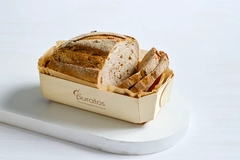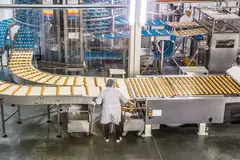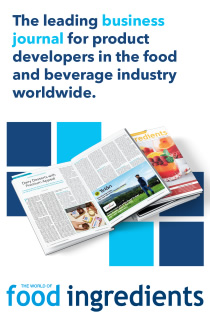Iba 2025 review: Fighting food waste, preserving taste and going plant-based in baking

Iba 2025 concluded last week in Düsseldorf, Germany, after a two-year hiatus. We met with baking industry leaders who highlighted numerous trends and drivers in the segment, including the latest in taste formulations, food waste issues, naturality, plant-based confectionery, and labor shortages.
The event hosted over 1,300 exhibitors, with approximately 75,000 visitors worldwide. The exhibition area spanned over 132,000 square meters.
Ingredient producers discussed cleaner label demands, natural alternatives, and nutrient enrichment. Cost concerns and raw material challenges were also pinpointed amid R&D for cocoa and egg substitutes.
Food Ingredients First looks back at key highlights from the show floor.
Freshness against food waste
Food waste was spotlighted as a leading concern in the bakery segment. Therese O’Rourke, vice president of business development, Functional Ingredients, and Food Protection & Preservation, Europe at Kerry Group, cites research from the company’s “Left on the Shelf” study.
“The bakery industry is one of the single biggest contributors to food waste. There’s over 12 billion loaves of bread wasted every year,” she says.
The study identifies three core freshness factors — mold control, texture, and taste — as the top reasons consumers discard bakery products.
“To address these issues, we are adopting a multi-technology approach. This includes food protection for mold control, enzymes and emulsifiers for texture stability, and flavor solutions for taste consistency across shelf life,” O’Rourke explains.
Kerry presented a chocolate muffin concept at the show, featuring its enzyme and emulsifier blend, Biobake Fresh Rich, to preserve softness. The formulation also includes a cocoa flavor solution that allows a 50% reduction in cocoa content, achieving up to 30% cost savings and over 20% CO2 emissions reduction.
 Optimized baking methods were showcased amid efforts to speed up production and prolong shelf life.
Optimized baking methods were showcased amid efforts to speed up production and prolong shelf life.
Reduction strategies and nutritional reformulation
O’Rourke notes that consumers increasingly evaluate ingredient labels. “Our consumers are continuing to be more discerning when they look at packaging. They really understand food labeling,” she says.
Clean label demands include reducing the use of additives and E-numbers, with concurrent expectations for high-quality texture and taste.
“We are working with customers on reduction strategies — reducing salt, sugar, and fat — while maintaining product performance across shelf life. Nutrition remains a theme, including positioning products as sources of fibre or protein,” she adds.
These factors influence how products are reformulated for better consumer acceptance and environmental impact. Kerry’s reformulation strategies are also designed to align with cost-efficiency targets.
Enzyme solutions, sourdough technology
Stephen Anderson, business director for Europe at Lallemand Baking Solutions, highlights enzyme solutions and sourdough technologies as tools for addressing multiple bakery manufacturing priorities.
“For us this year, it’s about showing people what we’ve got in enzyme solutions and sourdough technology. They’re key functional ingredients for maker ease,” he says. “We look at the whole process and formulation. It’s about how we apply enzymes to maximize functionality and optimize production.”
He highlights Lallemand’s bake time reduction enzyme. “That enzyme is clean label and allows process optimization. Reducing baking time increases throughput and decreases energy use per unit.”
Anderson identifies current market challenges. “We still see trends toward indulgence and clean labels. Sustainability is significant. There’s also pressure on cost, so we need efficient solutions that meet these requirements.”
He adds that consumer segmentation is influencing product development. “Some consumers seek indulgence with premium mouthfeel, while others are health-focused. These expectations require solutions for taste and enrichment, such as high fiber and whole grain content.”
Lallemand’s technologies aim to address formulation challenges that arise when incorporating these elements. “Health-conscious formulations pose processing challenges, and that’s where enzyme solutions play a role,” he states.
Anderson also responds to the long-standing reduction in carbohydrate consumption. “We need carbohydrates. It’s about balance and moderation. Smaller portion sizes and improved formulations allow bakery products to deliver nutritional value alongside carbohydrates.”
 Cargill’s Van Been highlighted its “Indulgence Redefined” chocolate alternative concept.
Cargill’s Van Been highlighted its “Indulgence Redefined” chocolate alternative concept.
Ingredient and sensory innovation
Camiel Van Beek, Cargill’s category director for bakery, introduced the company’s dual concept booth at Iba. “We divided our stand into two sections. One is for essential solutions — like fillings and coatings. The other showcases innovations in inclusions and decorations,” he explains.
He highlights growing consumer interest in multisensory bakery experiences. “Consumers want more sensorial dimensions. Products should deliver in taste, texture, and visual appeal.”
“We show applications with a wide range of colors, textures, and combinations, like our croissant-donut hybrid.”
Cargill also presented a new confectionery concept — Indulgence Redefined — as a chocolate alternative. “It can be used as a coating, filling, or inclusion and offers up to 90% reduction in carbon footprint,” Van Beek notes.
He states that functionality and sustainability must align. “The product must maintain its sensory profile, shelf life, and processing capability. It should be easy to integrate into current production lines.”
Cargill also addresses raw material price volatility and availability. “There’s growing difficulty sourcing ingredients like cocoa and eggs. We provide affordable alternatives and ready-to-use solutions,” he says. “These include prototypes and recipe guidance to help customers respond to market needs quickly.”
Looking forward, Van Beek anticipates a continuation of existing demands with new pressures. “There will be an increase in personalization and health requirements.”
“Consumers will have more specific expectations for sustainability and nutrition,” he says.
He emphasizes that bakery manufacturers will need to respond faster and offer broader formulation flexibility. “The number of product variations will grow. We expect an increase in demand for tailored, health-aligned, and sustainable bakery items.”

















